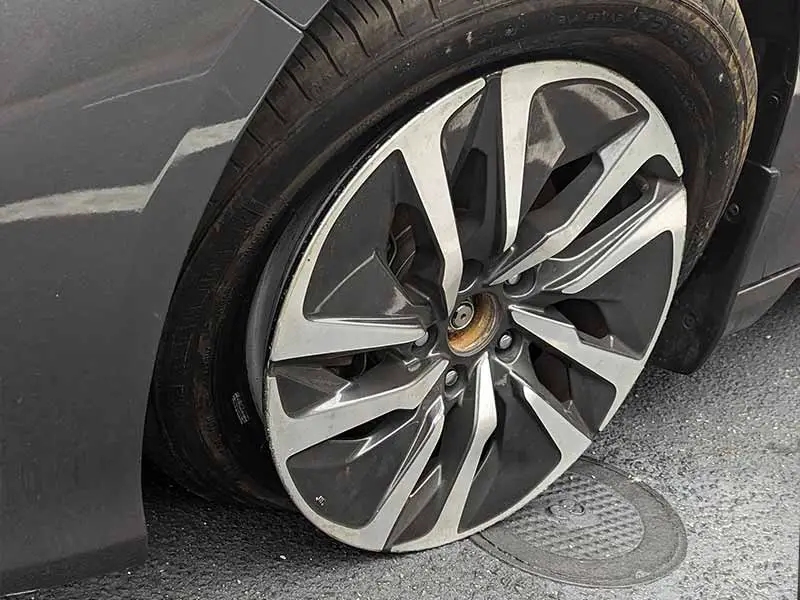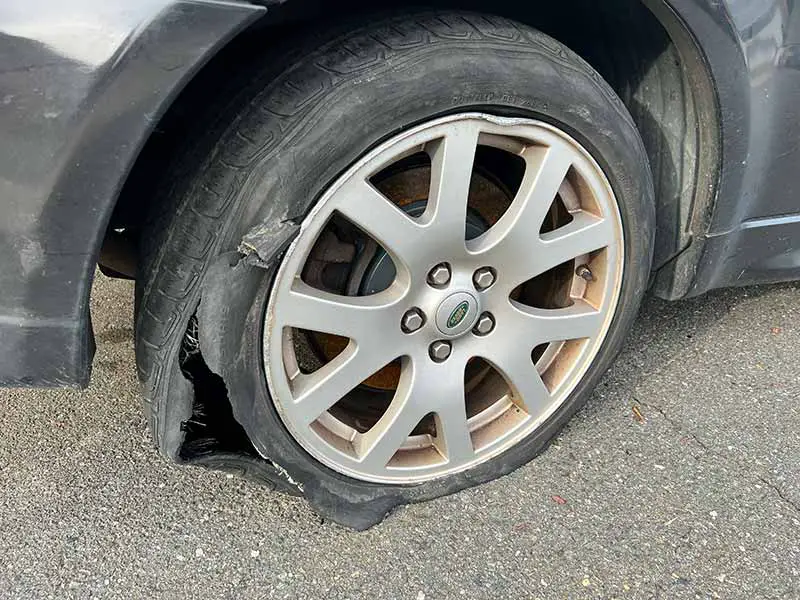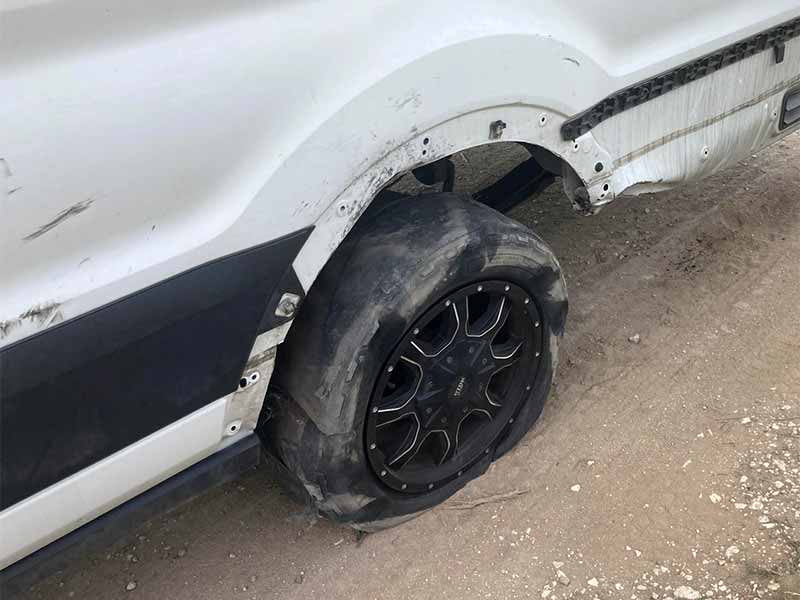Ever wondered just how much a sudden tire blowout can impact your beloved ride? It’s not just about the scare and the noise—it’s about the potential havoc on your vehicle.
Can A Tire Blowout Damage Your Car?
Yes, a tire blowout can damage your car. It can lead to rim damage, affect alignment, and potentially cause body damage or mechanical issues.
In this article, we will explore the various ways a tire blowout can damage your car, from the immediate impact to long-term effects, and provide insights into prevention, detection, and handling strategies for such incidents.

Types of Vehicle Damage from a Tire Blowout
When a tire blowout occurs, the damage to your vehicle can range from minor to severe, affecting various components. Understanding these can help you assess and address the issues promptly. Here’s what you might be dealing with:
Tire and Wheel Damage
- Tire Destruction: The most obvious damage. A blowout can shred the tire, leaving it completely unusable.
- Rim Damage: As the tire deflates and collapses, the rim may contact the road, causing bends, cracks, or scratches.
Body and Paint Damage
- Debris Impact: Pieces of the blown tire can strike the vehicle’s body, leading to scratches, dents, or even broken components.
- Skirting and Bumper Damage: Particularly in a severe blowout, the car’s skirting or bumpers can be damaged due to the sudden change in motion or impact with road debris.
Undercarriage Components
- Brake Lines and Suspension: A tire blowout can lead to loss of control, causing the vehicle to dip or dive abruptly. This can strain or damage the suspension and brake lines.
- Exhaust System: If the vehicle swerves or bottoms out, the exhaust system may sustain damage.
Alignment Issues
- Steering Misalignment: The sudden loss of tire pressure can cause the vehicle to jerk violently, potentially leading to alignment issues.
- Handling Difficulties: Post-blowout, the vehicle might not handle as smoothly, indicating possible damage to steering or suspension components.
Mechanical and Electrical Damage
- Wiring and Hoses: Debris or the flailing tire remnants can damage vulnerable parts under the vehicle, including wiring harnesses and hoses.
- Sensors and Systems: Modern vehicles have numerous sensors around the wheel well that can be damaged in a blowout, affecting everything from tire pressure monitoring to stability control systems.
Assessing the Damage
After a blowout, it’s important to:
- Inspect Visually: Once it’s safe, examine the tire area, undercarriage, and body for visible signs of damage.
- Professional Check-Up: Even if the damage isn’t apparent, a professional inspection is crucial to ensure safety and functionality. Hidden damages can have serious consequences down the road.

Preventing Tire Blowouts
Knowledge is power, especially when it comes to preventing tire blowouts. Let’s explore how regular maintenance, awareness, and a bit of vigilance can keep you safely rolling along.
What Causes a Tire Blowout?
Understanding the culprit behind these dramatic tire tantrums is key to prevention. Here are the usual suspects:
- Overloading: Your tires have a weight limit. Exceeding this can invite trouble.
- Underinflation: Too little air leads to too much tire touching the road, causing heat and, eventually, failure.
- Overinflation: Too much air isn’t good either. It makes the tire rigid and more prone to damage from potholes or debris.
- Wear and Tear: Tires aren’t forever. Old, worn-out tires are accidents waiting to happen.
- Damage: Nails, glass, or other road hazards can lead to sudden air loss.
And the number one cause? It’s typically underinflation. Driving on tires with less air than needed is like running a marathon with no training — something’s going to give!
Regular Maintenance and Inspection
Your car’s tires are like the shoes on your feet — take care of them, and they’ll take care of you. Here’s what you need to do:
- Check Tire Pressure Regularly: This isn’t a once-a-year thing. Monthly checks are a good rhythm. Remember, the right pressure keeps the blowouts away!
- Inspect Tires for Wear and Tear: Look for cracks, bulges, or anything that seems off. It’s like checking for bruises or bumps after a day of heavy lifting.
- Rotate Your Tires: Regular rotation ensures even wear, extending the life of your tires and improving performance.
Recognizing Warning Signs
Just like your body gives you signs when something’s wrong, so do your tires. Here are the symptoms to watch for:
- Vibrations or Unusual Noises: If your car suddenly feels like a massage chair or sounds like a drumline, something might be up.
- Visible Damage: If you see something, do something. Don’t ignore cuts, bulges, or objects lodged in the tire.
- Pressure Alerts: Many cars now have a Tire Pressure Monitoring System (TPMS). If it lights up, don’t ignore it!
Embracing Tire Tech
Technology is here to help. Make the most of it:
- Use TPMS: It’s not just another light on the dashboard; it’s a critical warning system.
- Consider Quality Tires: Sometimes, spending a bit more upfront can save you a lot down the road.
Education is Key
- Learn About Your Tires: Know what type of tires you have, their lifespan, and their specific needs.
- Stay Informed: Keep up with recalls or news about your tire brand.

Dealing with a Tire Blowout
Even with the best prevention, sometimes the unexpected happens. A blowout can be a startling event, but knowing how to handle it can make all the difference. Let’s walk through the immediate steps to take during a blowout and what to do afterwards.
Immediate Steps to Take During a Blowout
Your tire has just burst, your heart is racing — what now? Here’s your action plan:
- Stay Calm: Keep a cool head. Panic leads to rash decisions.
- Maintain Your Grip: Firmly hold the steering wheel with both hands to stabilize the vehicle.
- Ease Off the Gas: Don’t slam the brakes. Instead, gently let off the gas and allow the car to slow down gradually.
- Steer Straight: While it might feel instinctive to swerve, try to keep the car going straight.
- Pull Over Safely: Once you’ve slowed to a safe speed, indicate and move to the side of the road.
After the Blowout: Assessing and Acting
Now that you’re safely stopped, it’s time to assess and act:
- Turn On Hazards: Let other drivers know you’re dealing with an emergency.
- Inspect the Damage: Once safe, take a look at the tire. If you have a spare and the know-how, you can change it; otherwise, call for help.
- Call for Assistance: Whether it’s roadside assistance or a tow truck, don’t hesitate to call for help.
Safety Tips to Remember
In these situations, safety is paramount. Here’s what to keep in mind:
- Avoid Changing Tires in Dangerous Locations: If you’re on a busy highway or in an unsafe area, it might be better to wait for professional help.
- Have an Emergency Kit: Keep essentials like reflective triangles, a flashlight, and a first aid kit in your car.
- Practice Tire Changing: Knowing how to change a tire in a calm setting can prepare you for doing it under stress.

Insurance and Tire Blowouts
After the dust settles from a tire blowout, you might be wondering about the financial implications. Understanding how insurance interacts with tire blowouts can save you from unexpected expenses and stress. Let’s delve into what’s generally covered and tips for dealing with insurance claims.
Is Damage from a Tire Blowout Covered by Insurance?
Insurance policies vary, but here are some general guidelines:
- Comprehensive and Collision Coverage: If you have comprehensive or collision coverage, damage to your vehicle caused by a blowout might be covered.
- Liability Coverage: This typically covers damage to other vehicles or property if you’re at fault, but not damage to your own car.
- Roadside Assistance: If you have this add-on, it can cover the cost of changing the tire or towing.
Understanding Your Policy
Each insurance policy is unique. Here’s how to get a handle on yours:
- Read the Fine Print: Know what’s covered and what’s not. Don’t wait until after an incident to find out.
- Ask About Tire Coverage: Some policies include specific provisions for tire damage. It’s worth asking your agent.
Tips for Dealing with Insurance Claims
If you find yourself needing to claim for a tire blowout, keep these pointers in mind:
- Document Everything: Take photos of the damage and the scene. Keep receipts for any immediate repairs or towing.
- Report Promptly: Notify your insurance as soon as possible. Delays can complicate the process.
- Be Detailed: When speaking with your insurance, provide a clear, detailed account of what happened.
Proactive Measures
To make any future claims smoother, consider these steps:
- Regular Reviews: Periodically review and adjust your coverage as needed. What made sense a few years ago might not fit your current situation.
- Keep Good Records: Maintain a log of maintenance, repairs, and any incidents. Good records can simplify claims.
Resources
Below are some links you may find helpful when learning about tires:
Final Thoughts
Prevention is key: regular inspections and maintenance can save lives. If you do experience a blowout, stay calm, maintain control, and safely guide your vehicle to a stop.
Know your insurance policy and what it covers in the case of tire damage. Stay informed, stay prepared, and drive safely.
Good luck and happy motoring.




